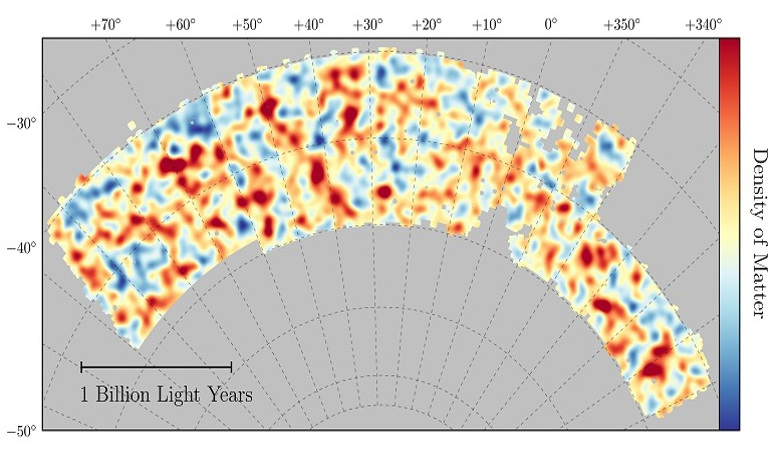Scientists have unveiled the most accurate measurement ever made of the present large-scale structure of the Universe – a result that helps to cement the theory that 26 percent of the universe is in the form of mysterious dark matter.
Confirmation that astrophysicists have a good understanding of how the Universe ages has been presented from data gathered from the Dark Energy Survey (DES). DES is a large international science collaboration of more than 400 scientists from 26 institutions in seven countries and they have been busy analysing the light from 26 million galaxies in order to study how structures in the Universe have changed over the past 7 billion years.
To look at this light, the DES collaboration used one of the most powerful cameras in existence; DECam. At 570-megapixels, this eye on the sky is attached to the 4-meter Victor M. Blanco Telescope at the Cerro Tololo Inter-American Observatory in Chile.
Nonetheless you can’t study how structures evolve unless you know how they looked in the first place. Luckily, data from the Planck satellite has already given scientists a snapshot of how the early Universe looked by studying the leftover radiation from the big bang; the cosmic microwave background (C.
But since that very early epoch in the Universe’s history, the gravity of dark matter has pulled mass together, while its more mysterious counterpart – dark energy – has been pushing it apart. Now, using the Planck map as a start along with DES data showing the Universe as it looks today, researchers can calculate precisely how these forces of nature have been battling it out for over 14 billion years.
"The DES measurements, when compared with the Planck map, support the simplest version of the dark matter/dark energy theory," said Joe Zuntz, of the University of Edinburgh, who worked on the analysis.
"For the first time, we're able to see the current structure of the universe with the same clarity that we can see its infancy, and we can follow the threads from one to the other, confirming many predictions along the way,” added Scott Dodelson of Fermilab, one of the lead scientists on this result.
“This allows us to test our models independently and combine both approaches to obtain parameter values with unprecedented precision,” added Risa Wechsler, a founding member of DES.
Astrophysicists need precise tests of the standard model of the Universe because its ingredients are not completely certain. The model – called Lambda-CDM – includes two key ingredients; cold dark matter (CDM) and dark energy. However dark matter has never been directly detected, while it is not known whether dark energy is actually a constant or changes over time.
Now that scientists have a good overall picture of how the Universe evolved, it looks like cosmologists do not need anything else but a constant form of dark energy to describe its expansion history.
The DES team have also created the largest guide to spotting dark matter in the cosmos by firstly creating maps of galaxy positions as tracers and then using gravitational lensing to map galaxy shapes over time.
"It is amazing that the team has managed to achieve such precision from only the first year of their survey," said National Science Foundation Program Director Nigel Sharp. "Now that their analysis techniques are developed and tested, we look forward with eager anticipation to breakthrough results as the survey continues."











